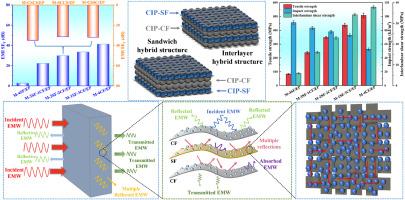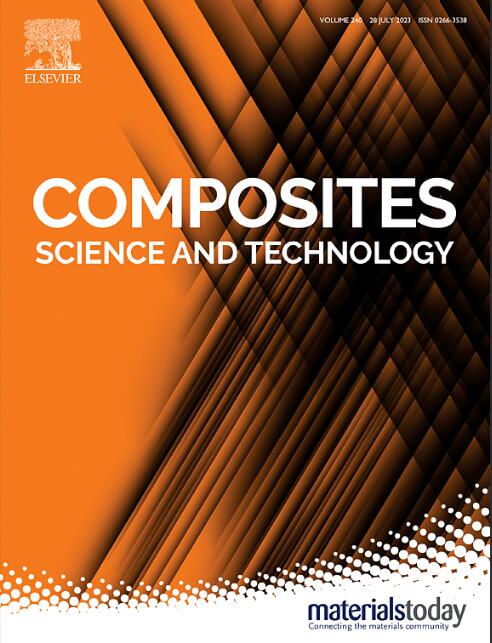Hybrid-structured carbon fiber fabric/silk fiber non-woven fabric/carbonyl iron powder/epoxy composites with highly efficient electromagnetic interference shielding and mechanical properties
IF 8.3
1区 材料科学
Q1 MATERIALS SCIENCE, COMPOSITES
引用次数: 0
Abstract
In this study, carbonyl iron powder (CIP) was loaded onto the surfaces of carbon fiber fabric (CF) and silk non-woven fabric (SF) through a spraying process and surface micro-dissolve & adhesion (SMDA) process, respectively. Subsequently, CF/SF/CIP reinforced epoxy (CF/SF/CIP/EP) composites with different hybrid structures were fabricated using vacuum-assisted resin transfer molding (VARTM) technique. The effects of these hybrid structures on both the electromagnetic interference (EMI) shielding performance and mechanical properties of the composites were systematically assessed. The results reveal that with an increase in the layer fraction of CF, the mechanical properties of the modified hybrid fibers (HFs) composites demonstrate a positive hybrid effect. Particularly noteworthy is the observation that when the layer ratio of CF to SF is maintained at 1:1, the M-CSCS/EP composites featuring an interlayer hybrid structure exhibit the highest EMI shielding effectiveness of 34.9 dB within the X-band of 8.2–12.4 GHz. This enhancement is attributed to the improved interfacial polarization loss capability of incident electromagnetic waves, facilitated by the increased two-phase interface formed between CF and SF. Moreover, the composite exhibits excellent mechanical properties, including a tensile strength of 339.9 MPa, interlaminar shear strength of 32.1 MPa, and impact strength of 98.2 kJ/m2. Consequently, the HFs composites developed in this study offer a commendable balance between EMI shielding performance and mechanical properties, rendering them highly suitable for a wide array of applications in aerospace, rail transportation, and communication equipment.

具有高效电磁干扰屏蔽和机械性能的混合结构碳纤维织物/丝纤维无纺布/羰基铁粉/环氧树脂复合材料
本研究通过喷涂工艺和表面微溶解& 粘附(SMDA)工艺,分别将羰基铁粉(CIP)负载到碳纤维织物(CF)和丝绸无纺布(SF)的表面。随后,利用真空辅助树脂传递模塑(VARTM)技术制作了具有不同混合结构的 CF/SF/CIP 增强环氧树脂(CF/SF/CIP/EP)复合材料。系统地评估了这些混合结构对复合材料电磁干扰(EMI)屏蔽性能和机械性能的影响。结果表明,随着 CF 层分数的增加,改性混合纤维 (HF) 复合材料的机械性能表现出积极的混合效应。尤其值得注意的是,当 CF 与 SF 的层比保持在 1:1 时,具有层间混合结构的 M-CSCS/EP 复合材料在 8.2-12.4 GHz 的 X 波段内表现出最高的 EMI 屏蔽效果(34.9 dB)。这种增强效果归因于 CF 和 SF 之间形成的两相界面增加,从而提高了入射电磁波的界面极化损耗能力。此外,该复合材料还具有优异的机械性能,包括 339.9 兆帕的拉伸强度、32.1 兆帕的层间剪切强度和 98.2 kJ/m2 的冲击强度。因此,本研究开发的高频复合材料在电磁干扰屏蔽性能和机械性能之间实现了令人称道的平衡,非常适合在航空航天、轨道交通和通信设备中广泛应用。
本文章由计算机程序翻译,如有差异,请以英文原文为准。
求助全文
约1分钟内获得全文
求助全文
来源期刊

Composites Science and Technology
工程技术-材料科学:复合
CiteScore
16.20
自引率
9.90%
发文量
611
审稿时长
33 days
期刊介绍:
Composites Science and Technology publishes refereed original articles on the fundamental and applied science of engineering composites. The focus of this journal is on polymeric matrix composites with reinforcements/fillers ranging from nano- to macro-scale. CSTE encourages manuscripts reporting unique, innovative contributions to the physics, chemistry, materials science and applied mechanics aspects of advanced composites.
Besides traditional fiber reinforced composites, novel composites with significant potential for engineering applications are encouraged.
 求助内容:
求助内容: 应助结果提醒方式:
应助结果提醒方式:


